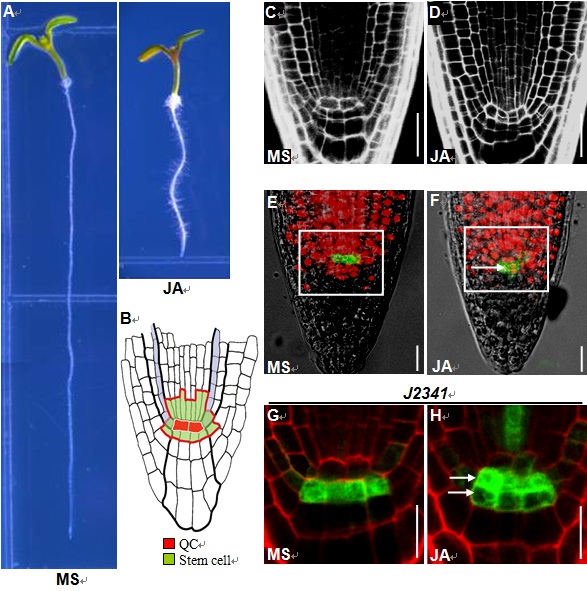The jasmonate family of oxylipins, including jasmonic acid (JA) and its metabolites, play a well-established role in mediating defense responses and a wide range of developmental processes. Among the first characterized physiological effects of jasmonate is growth inhibition. For example, in the reference species of Arabidopsis thaliana, jasmonate inhibits primary root growth and this action has been employed as the most prominent genetic assay to identify jasmonate-related mutants. However, the action mechanism governing JA-induced inhibition of plant growth remains elusive.
Prof. Chuanyou Li and his team in the Institute of Genetics and Developmental Biology (IGDB), Chinese Academy of Science (CAS) made new discoveries in understanding the cellular and molecular mechanisms of jasmonate action on the inhibition of primary root growth. They demonstrate that during jasmonate-induced inhibition of primary root growth, jasmonate reduces root meristem activity and leads to irregular QC division and columella stem cell differentiation. Consistently, jasmonate reduces the expression levels of the AP2-domain transcription factors PLETHORA1 (PLT1) and PLT2, which form a developmentally instructive protein gradient and mediate auxin-induced regulation of stem cell niche maintenance. Not surprisingly, the effects of jasmonate on root stem cell niche maintenance and PLT expression require the functioning of MYC2, a basic helix-loop-helix transcription factor that involves versatile aspects of jasmonate-regulated gene expression. Gel shift and chromatin immunoprecipitation experiments reveal that MYC2 directly binds the promoters of PLT1 and PLT2 and represses their expression. They propose that MYC2-mediated repression of PLT expression integrates jasmonate action into the auxin pathway in regulating root meristem activity and stem cell niche maintenance. This study illustrates a mode of jasmonate-auxin crosstalk, in which a major transcription factor of the JA signaling pathway directly represses master transcription factors known to act in the auxin pathway. This study extends the view of how plants can translate stress cues into growth response and thus retain growth plasticity during postembryonic development.
Entitled with “The Basic Helix-Loop-Helix Transcription Factor MYC2 Directly Represses PLETHORA Expression during Jasmonate-Mediated Modulation of the Root Stem Cell Niche in Arabidopsis [W],[OA]”, this work was published in the Plant Cell online on September 27, 2011(DOI:10.1105/tpc.111.089870). Graduate Student Qian Chen and Associate professor Jiaqiang Sun are co-first authors of this work. This work was supported by the National Basic Research Program of China and by the National Natural Science Foundation of China.
AUTHOR CONTACT:
Chuanyou Li, Ph.D.
Institute of Genetics and Developmetnal Biology, Chinese Academy of Sciences, Beijing, China.
E-mail: cyli@genetics.ac.cn

(Image by Qian Chen etc.)
Figure. Jasmonate inhibits Arabidopsis primary root growth and regulates root stem cell niche maintenance.(A) Six-d-old seedlings of wild type (WT, Col-0) were grown on medium without (MS) or with 20 µM JA (JA). (B) The structure of root stem cell niche of Arabidopsis. The stem cell niche is denoted with a red box. (C) and (D) Representative confocal images showing that JA promotes QC division. (E) and (F) EdU incorporation assays showing that JA promotes QC division. Red fluorescence of EdU-positive nuclei in QC cells of JA-treated roots indicates that QC is in a state of active division (white arrow).Bars = 20 µm. (G) and (H) JA induces deregulated division of CSCs, as revealed by the CSC-specific marker J2341. White arrows indicate the presence of two CSC layers in JA-treated roots. Bars = 20 µm.



